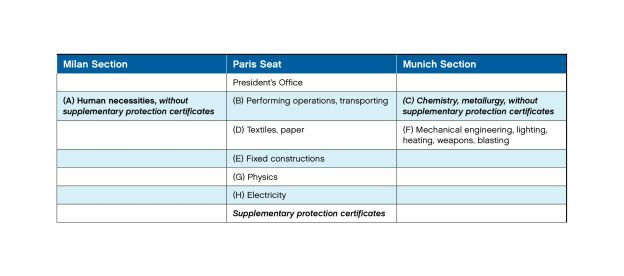The redistribution of competences to the Munich, Paris, and Milan central chambers takes shape and brings complexity for chemistry patents.
The restructuring of the central divisions of the Unified Patent Court ("UPC") is taking shape. Italy and the UPC have now signed the formal agreement on bringing the third seat of the UPC central division to Milan. If everything goes according to plan, the Milan central division is expected to open its doors on June 1, 2024.
Milan takes over the role originally assigned to London, which departed from the Unitary Patent project after Brexit. However, not all technology areas of competence originally assigned to the London division will be taken over by the Milan division, as some of these competences will go to the Munich and Paris central divisions.
Beginning June 1, 2024, standalone nullity cases will go to the three central divisions, according to the following distribution scheme based on the International Patent Classification ("IPC") sections of the patents at issue:
- Milan will have jurisdiction over disputes about IPC Section A patents (human necessities), without supplementary protection certificates. This comprises health, including biologics, pharmaceuticals and diagnostics, agriculture, tobacco, food, home appliances, clothing, furniture, sports and gaming, among others.
- Paris will have jurisdiction over disputes regarding patents of IPC Sections B (performing operations, transporting), D (textiles, paper), E (fixed constructions), G (physics), H (electricity), and supplementary protection certificates.
- Munich will have jurisdiction over disputes about IPC Section C patents (chemistry, metallurgy), without supplementary protection certificates, and over disputes about IPC Section F patents (mechanical engineering, lighting, heating, weapons, blasting).
Interestingly, while the pure chemical aspect is covered by Section C, the applied chemical aspect is covered by another section; for example, the use of a substance or composition for the treatment of animals and plants is covered by Section A; chemical processes and apparatus are covered by Section B; chemical methods of analysis and testing are covered by Section G. This split of competence might offer a strategic opportunity if both aspects are covered by the same patent or are subject of a number of attacked patents by the same patent holder.
Going forward, the IPC classification will have increasingly practical relevance for litigation strategy considerations.

The content of this article is intended to provide a general guide to the subject matter. Specialist advice should be sought about your specific circumstances.









